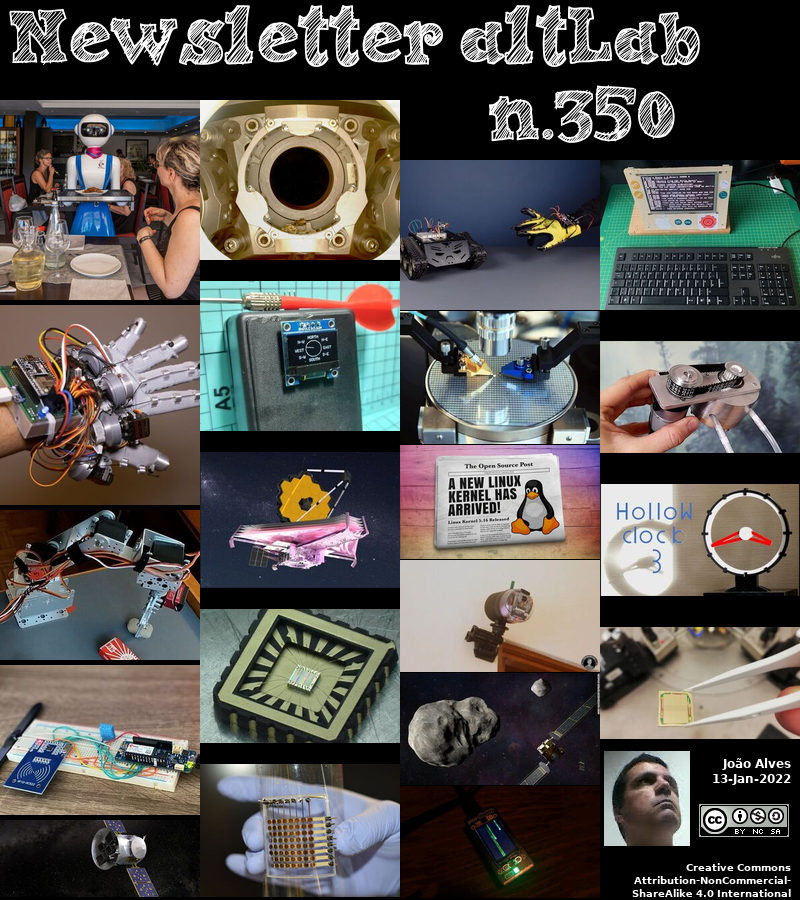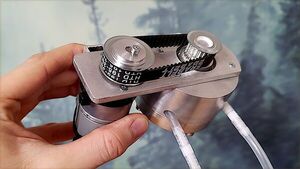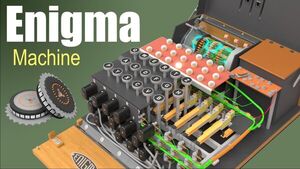2022-01-13 - Nº 350
Editorial
Esta é a Newsletter Nº 350 que se apresenta com o mesmo formato que as anteriores. Se gostar da Newsletter partilhe-a!
Todas as Newsletters encontram-se indexadas no link.
Esta Newsletter tem os seguintes tópicos:
Faz hoje anos que, em 1864, físico alemão Wilhelm Wien. Ele recebeu o Prémio Nobel da Física em 1911 pela sua lei de deslocamento relativa à radiação emitida pelo corpo negro perfeitamente eficiente (uma superfície que absorve toda a energia radiante que cai sobre ele). Ao estudar os fluxos de gás ionizado Wien, em 1898, identificou uma partícula positiva igual em massa ao átomo de hidrogénio. Wien, com este trabalho, lançou as bases da espectroscopia de massa. J. J. Thomson refinou o aparelho de Viena e realizou novas experiências em 1913, depois, após o trabalho de Ernest Rutherford em 1919, a partícula de Viena foi aceite e baptizada com o nome de protão. Wien também fez importantes contribuições para o estudo dos raios catódicos, raios X e raios de canal.
O nascimento da radiodifusão pública é atribuído a Lee de Forest, que transmitiu a primeira emissão pública mundial em Nova Iorque a 13 de Janeiro de 1910. Esta emissão apresentava as vozes de Enrico Caruso e de outras estrelas da Ópera Metropolitana. Membros do público e da imprensa utilizaram auscultadores para ouvir a emissão em vários locais de toda a cidade. Isto marcou o início do que viria a ser uma comunicação rádio sem fios quase universal.
Nesta semana que passou foi lançado o Kernel de Linux 5.16. A grande novidade desta versão é a introdução de uma nova system call chamada FUTEX2 ou futex_waitv(). Contribuído pela Collabora, esta funcionalidade poderá ajudar a melhorar a experiência de jogos nativos Linux mas, mais concretamente, para jogos Windows a correr via Wine. Permite que os jogos esperem por múltiplos 'futexes' com uma única chamada de sistema, o que deverá ajudar a reduzir a utilização da CPU e aumentar o FPS para muitos jogos. Adicionalmente os relatórios de estabilidade dos sistemas de ficheiros (filesystems) recebem uma grande melhoria com uma nova API baseada no fanotify, embora actualmente apenas suportado em sistemas EXT4. Cada actualização do Kernel melhora o suporte gráfico, e esta 5.16 não é excepção, oferecendo DisplayPort 2.0 ao driver da GPU AMD antes das placas de próxima geração que o distribuem; mais trabalho de base para gráficos DG2/Alchemist e, relacionado, suporte 'estável' para gráficos Intel Alder Lake S (i.e. DG1). Foi adicionado suporte para as instruções Intel AMX, assim como para os controladores Joy-Con e Pro da Nintendo e para o DualSense LED em controladores Playstation 5. Foram feitas melhorias ao nível do suporte de diversos dispositivos Microsoft Surface e um novo driver para o Realtek 802.11ax. Resta agora aguardar que as distribuições main-stream peguem neste kernel e o disponibilizem compilado para as mesmas.
Na Newsletter desta semana apresentamos diversas noticias, artigos científicos, projetos de maker e alguns vídeos interessantes.
 João Alves ([email protected])
João Alves ([email protected])
O conteúdo da Newsletter encontra-se sob a licença  Creative Commons Attribution-NonCommercial-ShareAlike 4.0 International License.
Creative Commons Attribution-NonCommercial-ShareAlike 4.0 International License.
Novidades da Semana

Linux Kernel 5.16 Released – And Gamers Will Love It
"The Linux Kernel just received its major update of the year — and if you’re a gamer, it’s a corker! Linus Torvalds announced the availability of Linux kernel 5.16 exactly where he always announces it: the Linux kernel mailing list. The Linux 5.16 release was delayed by week or so due to the appearance of a red-suited bearded fellow, something Torvalds notes in his announcement where he quips: “we had that extra week due to the holidays, and it’s not like we had lots of last-minute things that needed to be sorted out”. So what’s new? What’s New in Linux 5.16? Well, Linux 5.16 introduces a new kernel system called called FUTEX2, or futex_waitv()." [...]
Outras Notícias

Toshiba Expands Line-up of Ethernet Bridge ICs for Automotive Information Communications Systems and Industrial Equipment
"Toshiba Electronic Devices & Storage Corporation ("Toshiba") has added “TC9563XBG” to its line-up of Ethernet bridge ICs, to provide support for 10Gbps communications in automotive information communications systems and industrial equipment. Sample shipments have started and volume production will start in August 2022. Automotive networks are evolving toward zone architecture[1], where communications between zones use real-time, multi-gig[2] transmission via Ethernet at a rate of 1Gbps or higher. The new bridge IC has Toshiba’s first 2-port 10Gbps Ethernet, and the interface can be selected from USXGMII, XFI, SGMII, and RGMII[3]. The two ports support Ethernet AVB[4] and TSN[5], which facilitate real-time processing and synchronous processing, respectively. They also support “simplified” SR-IOV (virtual functions)." [...]
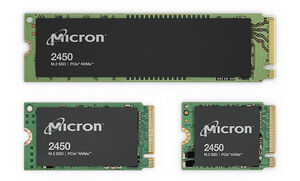
Micron Ships the Industry’s First 176-Layer QLC NAND in Volume and Unveils the 2400 PCIe Gen4 Client SSD
"Micron Technology, Inc. (Nasdaq: MU), today announced it has begun volume shipments of the world's first 176-layer QLC NAND SSD. Built with the most advanced NAND architecture, Micron’s 176-layer QLC NAND delivers the industry’s leading storage density and optimized performance for a broad range of data-rich applications. Designed for use cases spanning client and data center environments, Micron’s transformative new NAND technology is now available with the introduction of the Micron 2400 SSD, the world’s first 176-layer PCIe Gen4 QLC SSD for client applications. The new 176-layer QLC NAND will also be incorporated into select Micron Crucial consumer SSDs, and available as a component for system designers. Micron’s groundbreaking 176-layer QLC NAND provides a layer count and density unprecedented in QLC NAND flash and follows Micron’s delivery of the industry’s first 176-layer TLC NAND. Additionally, Micron’s 176-layer QLC NAND enables 33% higher I/O speed1 and 24% lower read latency2 than Micron’s prior generation solution." [...]
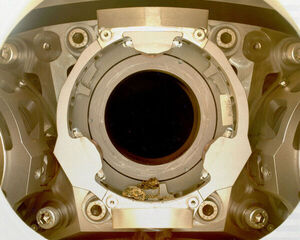
Assessing Perseverance's Seventh Sample Collection
"On Wednesday, Dec. 29 (sol 306) Perseverance successfully cored and extracted a sample from a Mars rock. Data downlinked after the sampling indicates that coring of the rock the science team nicknamed Issole went smoothly. However, during the transfer of the bit that contains the sample into the rover’s bit carousel (which stores bits and passes tubes to the tube processing hardware inside the rover), our sensors indicated an anomaly. The rover did as it was designed to do - halting the caching procedure and calling home for further instructions. This is only the 6th time in human history a sample has been cored from a rock on a planet other than Earth, so when we see something anomalous going on, we take it slow. Here is what we know so far, and what we are doing about it." [...]

PCI-SIG® Releases PCIe® 6.0 Specification Delivering Record Performance to Power Big Data Applications
"PCI-SIG®, the organization responsible for the widely adopted PCI Express® (PCIe®) standard, today announced the official release of the PCIe 6.0 specification, reaching 64 GT/s. PCIe 6.0 Specification Features - 64 GT/s raw data rate and up to 256 GB/s via x16 configuration - Pulse Amplitude Modulation with 4 levels (PAM4) signaling and leverages existing PAM4 already available in the industry - Lightweight Forward Error Correct (FEC) and Cyclic Redundancy Check (CRC) mitigate the bit error rate increase associated with PAM4 signaling - Flit (flow control unit) based encoding supports PAM4 modulation and enables more than double the bandwidth gain - Updated Packet layout used in Flit Mode to provide additional functionality and simplify processing - Maintains backwards compatibility with all previous generations of PCIe technology PCI Express technology has served as the de facto interconnect of choice for nearly two decades. The PCIe 6.0 specification doubles the bandwidth and power efficiency of the PCIe 5.0 specification (32 GT/s), while providing low latency and reduced bandwidth overhead. “PCI-SIG is pleased to announce the release of the PCIe 6.0 specification less than three years after the PCIe 5.0 specification,” said Al Yanes, PCI-SIG Chairperson and President. “PCIe 6.0 technology is the cost-effective and scalable interconnect solution that will continue to impact data-intensive markets like data center, artificial intelligence/machine learning, HPC, automotive, IoT, and military/aerospace, while also protecting industry investments by maintaining backwards compatibility with all previous generations of PCIe technology.” “With the PCI Express SSD market forecasted to grow at a CAGR of 40% to over 800 exabytes by 2025, PCI-SIG continues to meet the future needs of storage applications,” said Greg Wong, Founder and Principal Analyst, Forward Insights. “With the storage industry transitioning to PCIe 4.0 technology and on the cusp of introducing PCIe 5.0 technology, companies will begin adopting PCIe 6.0 technology in their roadmaps to future-proof their products and take advantage of the high bandwidth and low latency that PCI Express technology offers.” “There is a growing demand for ever-increasing performance in many segments in the data center such as high-performance computing and AI,” said Ashish Nadkarni, Group Vice President, Infrastructure Systems, Platforms and Technologies Group, IDC." [...]

A 3,400-foot-wide asteroid will make a safe flyby of Earth next week
"A huge asteroid will safely whiz by our planet next week. The asteroid, known as 7482 (1994 PC1), will make its closest approach to our planet on Jan. 18 at 4:51 p.m. EST (2151 GMT), according to a table from the Center for Near-Earth Object Studies (CNEOS), managed by NASA at the agency's Jet Propulsion Laboratory in California. The 3,400-foot (1 kilometer) asteroid will zoom by our planet at the equivalent of five lunar distances at its closest approach, the table indicates, at a top speed of nearly 12 miles per second (20 km/s). At this distance, this will be a safe flyby, and the closest one the asteroid will make of Earth in the next 200 years, according to EarthSky. Asteroids are space rocks that are leftovers of the early solar system when our neighborhood was filled with objects like it. Tens of thousands of asteroids exist but only a subset of them pass close enough to Earth to be termed near-Earth objects (NEOs)." [...]
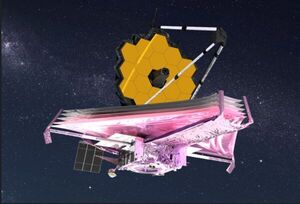
NASA’s Webb Telescope Reaches Major Milestone as Mirror Unfolds
"NASA’s James Webb Space Telescope team fully deployed its 21-foot, gold-coated primary mirror, successfully completing the final stage of all major spacecraft deployments to prepare for science operations. A joint effort with the European Space Agency (ESA) and Canadian Space Agency, the Webb mission will explore every phase of cosmic history – from within our solar system to the most distant observable galaxies in the early universe. “Today, NASA achieved another engineering milestone decades in the making. While the journey is not complete, I join the Webb team in breathing a little easier and imagining the future breakthroughs bound to inspire the world,” said NASA Administrator Bill Nelson. “The James Webb Space Telescope is an unprecedented mission that is on the precipice of seeing the light from the first galaxies and discovering the mysteries of our universe. Each feat already achieved and future accomplishment is a testament to the thousands of innovators who poured their life’s passion into this mission.” The two wings of Webb’s primary mirror had been folded to fit inside the nose cone of an Arianespace Ariane 5 rocket prior to launch." [...]
Ciência e Tecnologia
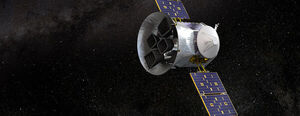
Unusual team finds gigantic planet hidden in plain sight
"A UC Riverside astronomer and a group of eagle-eyed citizen scientists have discovered a giant gas planet hidden from view by typical stargazing tools. The planet, TOI-2180 b, has the same diameter as Jupiter, but is nearly three times more massive. Researchers also believe it contains 105 times the mass of Earth in elements heavier than helium and hydrogen. Nothing quite like it exists in our solar system. Details of the finding have been published in the Astronomical Journal and presented at the American Astronomical Society virtual press event on Jan. 13. “TOI-2180 b is such an exciting planet to have found,” said UCR astronomer Paul Dalba, who helped confirm the planet’s existence." [...]

Dark Energy Spectroscopic Instrument (DESI) Creates Largest 3D Map of the Cosmos
"The Dark Energy Spectroscopic Instrument (DESI) has capped off the first seven months of its survey run by smashing through all previous records for three-dimensional galaxy surveys, creating the largest and most detailed map of the universe ever. Yet it’s only about 10% of the way through its five-year mission. Once completed, that phenomenally detailed 3D map will yield a better understanding of dark energy, and thereby give physicists and astronomers a better understanding of the past – and future – of the universe. Meanwhile, the impressive technical performance and literally cosmic achievements of the survey thus far are helping scientists reveal the secrets of the most powerful sources of light in the universe. DESI is an international science collaboration managed by the Department of Energy’s Lawrence Berkeley National Laboratory (Berkeley Lab) with primary funding for construction and operations from DOE’s Office of Science. DESI scientists are presenting the performance of the instrument, and some early astrophysics results, this week at a Berkeley Lab-hosted webinar called CosmoPalooza, which will also feature updates from other leading cosmology experiments." [...]

Physicists detect a hybrid particle held together by uniquely intense “glue”
"The discovery could offer a route to smaller, faster electronic devices. In the particle world, sometimes two is better than one. Take, for instance, electron pairs. When two electrons are bound together, they can glide through a material without friction, giving the material special superconducting properties. Such paired electrons, or Cooper pairs, are a kind of hybrid particle — a composite of two particles that behaves as one, with properties that are greater than the sum of its parts. Now MIT physicists have detected another kind of hybrid particle in an unusual, two-dimensional magnetic material." [...]
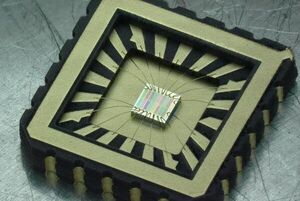
New tiny sensor makes the invisible visible
"A TU/e research group has developed a new near-infrared sensor that is easy to make, comparable in size to sensors in smartphones, and ready for immediate use in industrial process monitoring and agriculture. This breakthrough has just been published in Nature Communications, with co-first author Kaylee Hakkel defending her PhD thesis on January 14th. The human eye is a marvelous sensor. Using three different types of photoreceptor cone cells that convert visible light into signals for different colors, the eye gives essential information about the world around us. “When our brain puts the signals together, it makes a prediction of what the signals mean based on our experiences. For example, a red strawberry is sweet, but a green one is not”, explains Kaylee Hakkel, PhD researcher in the Photonics and Semiconductor Nanophysics group at the department of Applied Physics and co-first author of the study." [...]
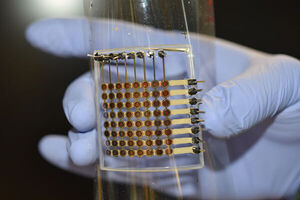
Researchers develop first fully 3D-printed, flexible OLED display
"Technology opens door to ubiquitous, more easily fabricated electronic screens In a groundbreaking new study, researchers at the University of Minnesota Twin Cities used a customized printer to fully 3D print a flexible organic light-emitting diode (OLED) display. The discovery could result in low-cost OLED displays in the future that could be widely produced using 3D printers by anyone at home, instead of by technicians in expensive microfabrication facilities. The research is published in Science Advances, a peer-reviewed scientific journal published by the American Association for the Advancement of Science (AAAS). The OLED display technology is based on the conversion of electricity into light using an organic material layer. OLEDs function as high quality digital displays, which can be made flexible and used in both large-scale devices such as television screens and monitors as well as handheld electronics such as smartphones. OLED displays have gained popularity because they are lightweight, power-efficient, thin and flexible, and offer a wide viewing angle and high contrast ratio." [...]
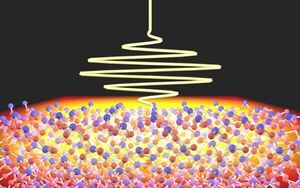
Light-Matter Interactions Simulated on the World's Fastest Supercomputer
"Light-matter interactions form the basis of many important technologies, including lasers, light-emitting diodes (LEDs), and atomic clocks. However, usual computational approaches for modeling such interactions have limited usefulness and capability. Now, researchers from Japan have developed a technique that overcomes these limitations. In a study published this month in The International Journal of High Performance Computing Applications, a research team led by the University of Tsukuba describes a highly efficient method for simulating light-matter interactions at the atomic scale. What makes these interactions so difficult to simulate? One reason is that phenomena associated with the interactions encompass many areas of physics, involving both the propagation of light waves and the dynamics of electrons and ions in matter." [...]
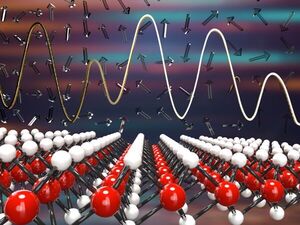
Solving the ‘big problems’ via algorithms enhanced by 2D materials
"Important optimization algorithms that are designed to solve large-scale problems such as airline schedules and supply chain logistics may soon get a boost from 2D materials that will enable the algorithms to better solve the problems and use less energy, according to Penn State researchers. These large-scale issues are known as combinatorial optimization problems, the term for a set of problems that are so complex that finding the best solution using an exhaustive search is sometimes unfeasible. Therefore, algorithms are valuable tools in solving these problems by finding the best possible solution. “These are problems that we face in our everyday life, such as scheduling of transportation or supply chain logistics, and you need to really optimize the best way of doing it correctly,” said Saptarshi Das, associate professor of engineering science and mechanics and primary investigator for the study that was recently published in Advanced Materials. “One famous example is the Traveling Salesman Problem, where a salesman has to go from city A to city B to city C to city D, but he has to find the optimal route where he can visit each city exactly once in the shortest time and return home.” These problems are important ones to solve, as they affect how fast we receive goods and services, how expensive they are for customers and how efficient our society’s logistics are for anything from defense to transportation. “Somebody has to solve these problems but the amount of resources needed from a computational perspective is enormous in order to run these algorithms,” Das said." [...]
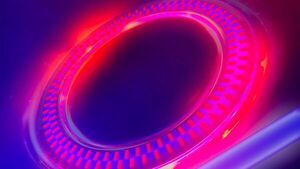
An optical chip improved by light
"At EPFL, a team of scientists created and observed a new physical phenomenon on an optical chip using modified lights. Technology is increasingly moving towards miniaturization and energy efficiency. This also applies to electronic chips. Light, and optics more broadly, are functional in making compact and portable chips. Researchers from the Photonic Systems Laboratory, headed by Professor Camille Brès, have successfully applied a novel principle for introducing second-order optical nonlinearity into silicon nitride chips. A first reported in the journal Nature Photonics." [...]
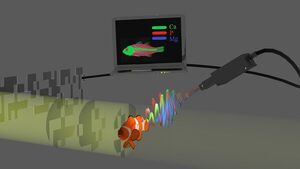
Researchers Use Ghost Imaging to Speed Up X-ray Fluorescence Chemical Mapping
"Researchers have developed a new, focus-free technique for creating chemical maps using x-ray fluorescence. The approach offers fast, high-resolution measurements, which could be useful for analyzing chemical composition for a range of applications in biomedicine, materials science, archeology, art and industry. “Our new method combines the well-known techniques of computational ghost imaging and x-ray fluorescence measurement to create a high-resolution and efficient way to produce chemical element maps,” said research team leader Sharon Shwartz from Bar Ilan University in Israel. “We expect it will allow the chemical mapping of larger objects at higher resolutions than is possible today while also enabling measurement of complex 3D objects.” In Optica, Optica Publishing Group’s journal for high-impact research, Shwartz and colleagues describe their new x-ray computational ghost fluorescence technique. The approach doesn’t require any focusing and reduces the scanning needed, which significantly shortens measurement time. Also, the fact that it can be tuned to detect specific elements while being blind to human tissues could enable new applications such as full-body security scanners that improve privacy." [...]

Computer Model Seeks to Explain the Spread of Misinformation, and Suggest Counter Measures
"It starts with a superspreader, and winds its way through a network of interactions, eventually leaving no one untouched. Those who have been exposed previously may experience little effect when exposed to a different variant. No, it’s not a virus. It’s the contagious spread of misinformation and disinformation— misinformation that’s fully intended to deceive. Now Tufts University researchers have come up with a computer model that remarkably mirrors the way misinformation spreads in real life. The work might provide insight on how to protect people from the current contagion of misinformation that threatens public health and the health of democracy, the researchers say." [...]

Tackling hard computational problems
"David Gamarnik has developed a new tool, the overlap gap property, for understanding computational problems that appear intractable. The notion that some computational problems in math and computer science can be hard should come as no surprise. There is, in fact, an entire class of problems deemed impossible to solve algorithmically. Just below this class lie slightly “easier” problems that are less well-understood — and may be impossible, too. David Gamarnik, professor of operations research at the MIT Sloan School of Management and the Institute for Data, Systems, and Society, is focusing his attention on the latter, less-studied category of problems, which are more relevant to the everyday world because they involve randomness — an integral feature of natural systems. He and his colleagues have developed a potent tool for analyzing these problems called the overlap gap property (or OGP)." [...]
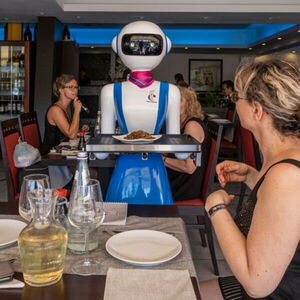
Algorithm helps robots avoid obstacles in their path
"If you’ve ever ordered a product from Amazon, chances are that a robot selected your purchase from a shelf, read the barcode and delivered it to the counter for packaging. Hopefully, it didn’t collide with a human worker on its journey and lose its way. The odds of that happening have now shortened, with University of South Australia researchers developing an algorithm to help robots avoid running into humans and other moving obstacles in their path. UniSA mechatronics engineering lecturer Dr Habib Habibullah and colleagues have built a computer model that ensures mobile robots can recognise and avoid unexpected obstacles, finding the quickest and safest path to their destination. In a new paper published in the Journal of Field Robotics, Dr Habibullah describes how his team combined the best elements of existing algorithms to achieve a collision-free TurtleBot able to adjust its speed and steering angles. “There are two types of path planning strategies for mobile robots, depending on whether they are being used in fixed environments or where they are encountering moving obstacles, such as humans or machines,” Dr Habibullah says." [...]
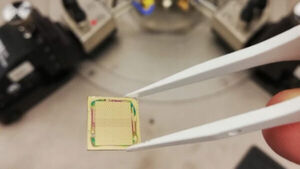
Nanowire transistor with integrated memory to enable future supercomputers
"For many years, a bottleneck in technological development has been how to get processors and memories to work faster together. Now, researchers at Lund University in Sweden have presented a new solution integrating a memory cell with a processor, which enables much faster calculations, as they happen in the memory circuit itself. In an article in Nature Electronics, the researchers present a new configuration, in which a memory cell is integrated with a vertical transistor selector, all at the nanoscale. This brings improvements in scalability, speed and energy efficiency compared with current mass storage solutions. The fundamental issue is that anything requiring large amounts of data to be processed, such as AI and machine learning, requires speed and more capacity. For this to be successful, the memory and processor need to be as close to each other as possible." [...]
Semiconductor demonstrates elusive quantum physics model
"With a little twist and the turn of a voltage knob, Cornell researchers have shown that a single material system can toggle between two of the wildest states in condensed matter physics: the quantum anomalous Hall insulator and the two-dimensional topological insulator. By doing so, they realized an elusive model that was first proposed more than a decade ago, but which scientists have never able to demonstrate because a suitable material didn’t seem to exist. Now that the researchers have created the right platform, their breakthrough could lead to advances in quantum devices. The team’s paper, “Quantum Anomalous Hall Effect from Intertwined Moiré Bands,” published Dec. 22 in Nature. The co-lead authors are former postdoctoral researchers Tingxin Li and Shengwei Jiang, doctoral student Bowen Shen and Massachusetts Institute of Technology researcher Yang Zhang. The project is the latest discovery from the shared lab of Kin Fai Mak, associate professor of physics in the College of Arts and Sciences, and Jie Shan, professor of applied and engineering physics in the College of Engineering, the paper’s co-senior authors." [...]

Euler’s 243-Year-Old ‘Impossible’ Puzzle Gets a Quantum Solution
"In 1779, the Swiss mathematician Leonhard Euler posed a puzzle that has since become famous: Six army regiments each have six officers of six different ranks. Can the 36 officers be arranged in a 6-by-6 square so that no row or column repeats a rank or regiment? The puzzle is easily solved when there are five ranks and five regiments, or seven ranks and seven regiments. But after searching in vain for a solution for the case of 36 officers, Euler concluded that “such an arrangement is impossible, though we can’t give a rigorous demonstration of this.” More than a century later, the French mathematician Gaston Tarry proved that, indeed, there was no way to arrange Euler’s 36 officers in a 6-by-6 square without repetition. In 1960, mathematicians used computers to prove that solutions exist for any number of regiments and ranks greater than two, except, curiously, six. Similar puzzles have entranced people for more than 2,000 years." [...]

Graphene could replace rare metal used in mobile phone screens
"A new study, published in the journal Advanced Optical Materials, is the first to show graphene can replace Indium Tin Oxide (ITO) in an electronic or optical device. Researchers from Paragraf and Queen Mary University of London demonstrated the successful fabrication of an Organic Light-Emitting Diode (OLED) with a monolayer graphene anode, replacing ITO in organic light-emitting diodes. Indium is one of the nine rarest elements in the Earth’s crust and is on the EU’s list of critical materials. However, it is widely used, mostly in the form of indium tin oxide (ITO), and a key part of the touch screens on our mobile phones and computers. Most homes will have many items containing indium, it’s used in flatscreen TVs, solar panels, as well as LED lights in our homes. This Innovate UK-funded research opens the door to a radical change in the potential of high-tech devices of the future by removing a limiting ingredient, Indium." [...]
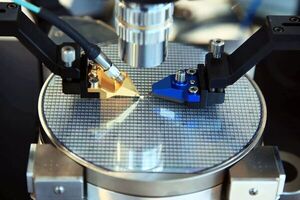
Mass production of revolutionary computer memory moves closer with ULTRARAM™ on silicon wafers for the first time
"A pioneering type of patented computer memory known as ULTRARAM™ has been demonstrated on silicon wafers in what is a major step towards its large-scale manufacture. ULTRARAM™ is a novel type of memory with extraordinary properties. It combines the non-volatility of a data storage memory, like flash, with the speed, energy-efficiency and endurance of a working memory, like DRAM. To do this it utilises the unique properties of compound semiconductors, commonly used in photonic devices such as LEDS, laser diodes and infrared detectors, but not in digital electronics, which is the preserve of silicon. Initially patented in the US, further patents on the technology are currently being progressed in key technology markets around the world. Now, in a collaboration between the Physics and Engineering Departments at Lancaster University and the Department of Physics at Warwick, ULTRARAM™ has been implemented on silicon wafers for the very first time." [...]
Atom by atom: new silicon computer chip technique opens up quantum computing construction possibilities
"Quantum computers could be constructed cheaply and reliably using a new technique perfected by a University of Melbourne-led team that embeds single atoms in silicon wafers, one-by-one, mirroring methods used to build conventional devices, in a process outlined in an Advance Materials paper. The new technique – developed by Professor David Jamieson and co-authors from UNSW Sydney, Helmholtz-Zentrum Dresden-Rossendorf (HZDR), Leibniz Institute of Surface Engineering (IOM), and RMIT – can create large scale patterns of counted atoms that are controlled so their quantum states can be manipulated, coupled and read-out. Lead author of the paper, Professor Jamieson said his team’s vision was to use this technique to build a very, very large-scale quantum device. “We believe we ultimately could make large-scale machines based on single atom quantum bits by using our method and taking advantage of the manufacturing techniques that the semiconductor industry has perfected,” Professor Jamieson said. The technique takes advantage of the precision of the atomic force microscope, which has a sharp cantilever that responds to the force fields above the surface of a chip with a positioning accuracy of just half a nanometre, about the same as the spacing between atoms in a silicon crystal. The team drilled a tiny hole in this cantilever, so that when it was showered with phosphorus atoms one would occasionally drop through the hole and embed in the silicon substrate." [...]
Projetos Maker
Diversos Projetos interessantes.
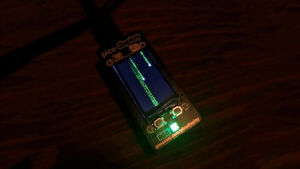
pico-display-matrix
"Digital rain animation gif with glow squeezed into a raspberry pi pico and pimoroni pico-display or how to actually use all Flash memory on your raspberry pi pico Background I wanted to have the matrix 'digital rain' effect on a small display. Instead of using a library, I wanted to use a 'nicely rendered' GIF file for animation. Due to the display resolution of 135x240 it resulted in a GIF with a large file size of 8MB. Because I was too lazy to implement an existing file compression I first just shortened and modified the animation manually (with GIMP you can modify each frame of a gif). Unfortunately, the file was still too large with roughly 4MB and then I decided to implement a primitive compression using just 16 custom colors (mainly different green tones and black). Then I used a python file to convert the gif to a .h file of what color to use from the palette for each pixel and each frame." [...]
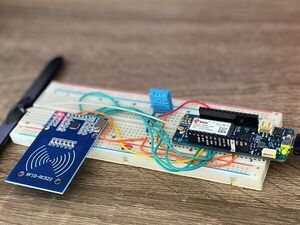
Automatic Attendance and Classroom Environmental Monitoring
"This project simulates a Smart Classroom automatic attendance using RFID module and classroom environmental monitoring using DHT11. Story As a teacher, taking attendance traditionally (roll call) is a time-consuming task, if automated the instructor can focus on other teaching activities. In this project RFID reader module and RFID cards will be used to implement an automatic attendance system. The classes are conducted inside a confined space and is difficult to attend a lecture if the environment is too hot or too cold. To achieve effective learning, the right physical environment inside the classroom should be maintained. The Relative Humidity and Temperature sensor(DHT11) will be used in this project to monitor the temperature and humidity and inform if the values are out of range." [...]

Mastermind - Arduino guess secret code
"Project to enable Arduino to play Mastermind and guess the secret code This project is based on the Master Mind game. The program allows Arduino to guess the secret code chosen by you. At each attempt, you will need to use buttons 1, 2, 3 to enter the key code. At each attempt, the algorithm finds all candidate codes as possible secret codes and plays one of them at random. The game ends when the entered key code confirms that the secret code has been guessed or if the played code is the only one that can be the secret code. " [...]
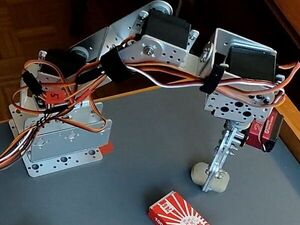
Robot Arm Automation
"This project has been developed for educational purposes and can be used in the field of robot development. This project has been developed for educational purposes and can be used in the field of robot development. Robotics is becoming accessible and easy to control. Nevertheless, it is necessary to pay particular attention to some technical aspects. Especially the handling of servo-motors. The project uses components that are easily found on the market." [...]
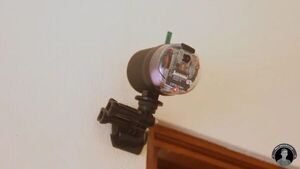
How to Make a WiFi Security Camera (ESP32-CAM) DIY Wireless CCTV Camera
"Hey, fellow makers! I welcome you to my first instructable about this Homemade wireless ESP32-CAM WiFi Surveillance Camera which we're going to make today to monitor our home, environment, or perhaps to even spy on someone ;) Even though decent commercial WiFi Security Cameras aren't all super expensive, they still cost quite a bit especially when you're wanting to buy several of them for your home security. In this instructable, you will learn how to make your own DIY Surveillance camera for cheap, under $15 depending on the supplies you may already have. This project will be based on the $9 ESP32-CAM AI thinker WiFi camera module, in my opinion, one of the best and cheapest camera development boards out there. With this security camera, you can log into the web server by typing in its unique IP address into your web browser, and view what the camera sees along with being able to change things around on the side control panels. The camera with its current code can save recorded .MJPEG video files to an SD card when something/someone moves in front of the camera triggering it to start recording." [...]
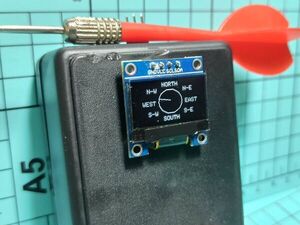
How to make a wind vane!
"How to build a wind indicator, simple and amazing" [...]
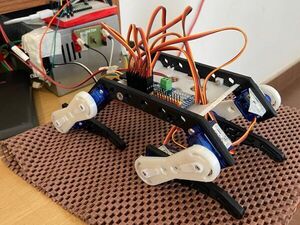
Simple Quadruped Robot
"Making a simple quadruped which can move in a straight under static stability. Preface This robot was built from scratch and I had to reiterate on the core concepts a couple times. It was built under tight time constraints. The final product here is not a 100% working model (yet) due to some software and hardware kinks ( I'll list the ones I found below). The codes have been put on my GitHub repository and any and all suggestions to improve upon it is most welcome. There are obviously better and more efficient ways to go about making it." [...]

LucidGloves: VR Haptic Gloves on a budget
"A functional glove that lets you use AND FEEL your hands in VR. This is a project to try to make VR Haptic Glove technology more available for the public. Currently, most VR Haptic Glove products out there are extremely expensive and are targeted for commercial use. In starting this project, I wanted to create a budget, but still well-functioning VR Haptic Glove that's cheap and easy for people to get their hands on (or in, lol), and that works Inside actual VR games. " [...]
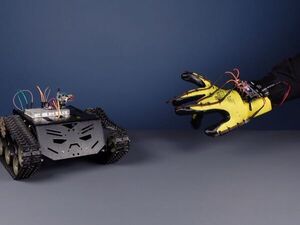
The Flexible Sensor Hand Controller
"The Flexible Sensor Hand Controller makes it possible to control your projects with your finger movements via wireless communication. The Flexible Sensor Hand Controller The Flexible Sensor Hand Controller makes it possible to control your projects with your finger movements via wireless communication. The flexible sensor hand controller acts as a transmitter. Also, in this project, we built the Arduino Robot Tank circuit with dual DC motor as a receiver. As a result, we have provided a Robot Tank control wirelessly with finger movements. Let's take a look at the video on "how it works?" [...]
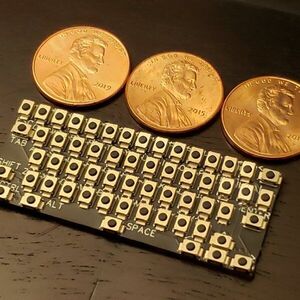
The Smallest Keyboard
"USB keyboard approximately the size of three pennies in a line I couldn't find a keyboard small enough for wearables and extremely small PCs, so I made one. " [...]

Casio Calculator External Memory (Casio FX92+)
"The inspiration for this project came initially from the Casio 92B, which was the recommended calculator for the humanities in Belgium and France. Unfortunately the 92B, except for its elegance, was not very impressive... Having recently discovered the 92+ and its algorithmic mode just after high school, I was happy to see that "the" calculator that had been with me for six years was going to keep me busy for a while! ...The only disappointment was of course that the 92+ has no internal memory. So I thought it would be interesting to create an external, detachable memory module to be able to save those long programs that become a heavy task to rewrite. Although this module can be compatible with any calculator (or any device with a matrix keyboard), it was primarily designed for the Casio FX-92+. Supplies - 1x Arduino Nano - 4x CD4066 Quad Bilateral Switch - 5x push button - 2x 10k ohm resistor" [...]

Build a 80s Style Home Computer From Scratch From Arduino Components
"This project began in a rainy summer 2021 in Corona lockdown when I started to write a BASIC interpreter for Arduino from scratch. The project was simple and mainly targeted for Arduino UNO and other small systems but has now outgrown this beginnings. This project is to show how one can build an entire standalone computer with it much like the ones which conquered the home computer market in the 80. For more details on how this started, the interpreter architecture and BASIC in general, please take a look into my repo https://github.com/slviajero/tinybasic/wiki. There is a small manual of the BASIC interpreter and the supported hardware. After two less ambitious projects of building asmall LCD shield BASIC computer and anAIM65 inspired system, this is the attempt to build a real computer." [...]

DIY a Thermal Imaging Monitor
"In this article, I will DIY a thermal imaging monitor using the ESP32-S2 parallel TFT touch screen and the MLX90640 Thermal imaging camera. It has been a long time since I want to make a thermal imaging monitorin the epidemic for our office.But the array thermal sensor was once very expensive in 2020, as there are huge demandsin the COVID-19, that I have to pause my plan, and until recently, I have the chance to do this.Of course, it is good to buy one from the market, but the price is expensive, and actually not so good as my design. Open source both on hardware& firmware. Supplies: - The parallel TFT Touch based on ESP32-S2, with resolution 320*240: The reason I use this touch is that: 1.) It has a much higher refresh rate than SPI display, check the comparison video at: https://youtu.be/fXq_TVa0oq4 2.) Based on ESP32-S2, with WIFi, so it can directly transmit the data/result to the local network, for remote monitoring." [...]
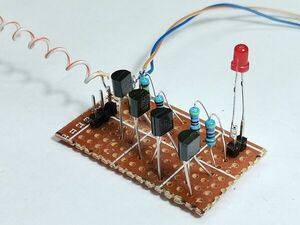
DIY Simple sensitive EMF Detector and Electroscope
"Inexpensive and functional instruments for the physics laboratory This time I will show you how to make two simple but very sensitive EMF (Electromagnetic Field ) Detectors. Electromagnetic fields are a combination of invisible electric and magnetic fields of force. They are generated by many devices like power lines, kitchen appliances, mobile phones, computers, but they are also generated by natural phenomena like the Earth’s magnetic field. Many such projects can be found on the Internet, but most often the only proof of their sensitivity and functionality is the text in the description of the project itself. So I decided to make two devices, one with discrete elements (transistors) and the other with an Integrated Circuit, and test their features that are shown in the video. First, let's analyze this device made with 4 transistors connected in cascade form." [...]
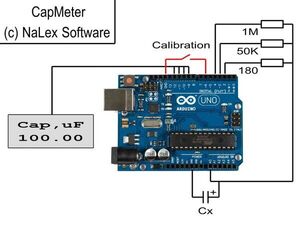
CapMeter - capacity meter from 10pF to 10mF
"Capacity meter with automatic selection of the measurement range. Capacity meter with automatic selection of the measurement range. It measures the charging and discharging times of the capacitor, and converts the measured values into capacitance. The measured capacity is from 10pF to 10mF (10000uF). A one-time meter calibration is required. For calibration, you need to turn on the meter with the calibration button pressed." [...]

Vga Boulder Crash
"A fun game on a vga screen with a insane 4 FPS! A while ago I had watch a video of someone make a vga graphics card, as a result I wanted to make something with vga, but I don't have the knowledge to do it. I ended up with a project on simple circuit and made it. After I made it I was bored with the stale text of the screen and decided to make a game. I'm not the most creative person, but my friend had a fun game that I decided to recreate and stick on a vga screen. The libraries are here you will need the vga and Adafruit graphics." [...]

Force-Sensing Telescoping EMT Conduit Pole
"In this Instructables article, I share a unique method for adding force-sensing to your DIY telescoping pole project made from EMT conduit, using an Arduino microcontroller and other off-the-shelf supplies! To create this DIY telescoping pole from EMT conduit with force-sensing capabilities, you will require the following tools and supplies. Disclosure: Some of the links below are affiliate links. This means that, at zero cost to you, I will earn an affiliate commission if you click through the link and finalize a purchase. - Arduino Nano clone microcontroller board - Strain gauges - SparkFun HX711 strain gauge amplifier SEN-13879 - Assorted resistors kit - Superglue - 22-gauge solid core hookup wire - Automatic wire stripper - Soldering iron - Rotary tube cutter for EMT conduit - Telescoping couplings/clamps for 1/2" to 3/4" EMT conduit, and 3/4 to 1" EMT conduit - (Optional) JST-SM connectors kit - (Optional) Electrical cable connectors crimping tool" [...]
Secção Videos
Videos interessantes.
That's all Folks!



